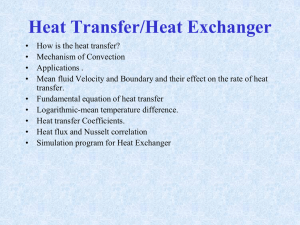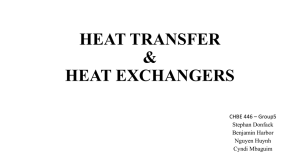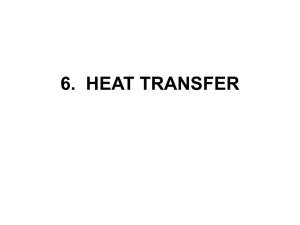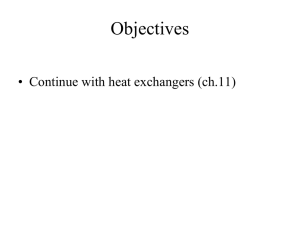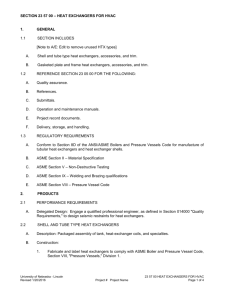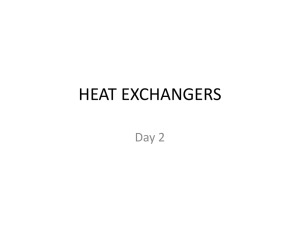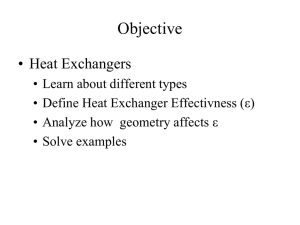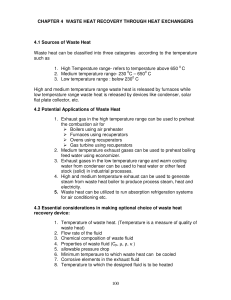Lecture 12-04
advertisement
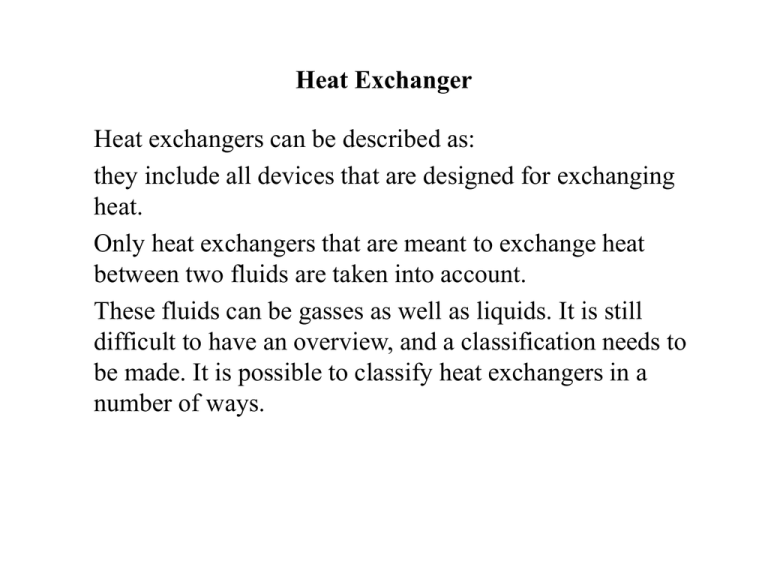
Heat Exchanger Heat exchangers can be described as: they include all devices that are designed for exchanging heat. Only heat exchangers that are meant to exchange heat between two fluids are taken into account. These fluids can be gasses as well as liquids. It is still difficult to have an overview, and a classification needs to be made. It is possible to classify heat exchangers in a number of ways. Classification Heat Exchangers 1.Classification of heat exchangers depending on the basic of the fluid paths through the heat exchanger. Difference is made between : • parallel flow, • counter flow • and cross flow. Classification cross flow air to liquid heat exchanger This is a heat exchangers that is found on the top buildings and is for instance needed for air conditioning inside. Here a fluid is leaded between the plates at the top of the heat exchanger and flows horizontally. Air is blown vertically against the plates to cool the fluid inside. Classification Classification The second classification made, is depending on the state of the media in the heat exchanger. Liquid-to-liquid exchangers are those in which two liquids interact. Also gas-to-gas heat exchangers like air preheaters in steam plants and helium-cooled reactor gas turbine plants have to be mentioned. These devices operate with heat transfer coefficients that are between ten and one hundred times lower than the coefficients of liquid-to-liquid exchangers. Gas to gas exchangers are general much larger and heavier if a same amount of transferred heat is demanded. The third type is the liquid-to-gas heat exchanger (or vice versa), usually water and air are used, for instance in automotive radiators. Because of the lower heat transfer coefficients on the gas-side there are usually fines placed on the exchanging surfaces. Classification The third classification method is based the purpose of heat exchanger. The last classification is actually the most important choice of the designer of a heat exchanging system. This is the choice what kind of construction he is going to use. Classification series of U-type constructions Shell-and-tube-heat exchanger with one shell pass and one tube pass; cross- counterflow operation Regenerative Heat Exchangers The regenerator represents class of heat exchangers in which heat is alternately stored and removed from a surface This heat transfer surface is usually referred to as the matrix of the regenerator. For continuous operation, the matrix must be moved into and out of the fixed hot and cold fluid streams. In this case, the regenerator is called a rotary regenerator. If, on the other hand, the hot and cold fluid streams are switched into and out of the matrix, the the regenerator is referred to as a fixed matrix regenerator. Heat Transfer of Heat Exchanger • • • • • • • • • How is the heat transfer? Mechanism of Convection Applications . Mean fluid Velocity and Boundary and their effect on the rate of heat transfer. Fundamental equation of heat transfer Logarithmic-mean temperature difference. Heat transfer Coefficients. Heat flux and Nusselt correlation Simulation program for Heat Exchanger How is the heat transfer? • Heat can transfer between the surface of a solid conductor and the surrounding medium whenever temperature gradient exists. Conduction Convection Natural convection Forced Convection Natural and forced Convection Natural convection occurs whenever heat flows between a solid and fluid, or between fluid layers. As a result of heat exchange Change in density of effective fluid layers taken place, which causes upward flow of heated fluid. If this motion is associated with heat transfer mechanism only, then it is called Natural Convection Forced Convection If this motion is associated by mechanical means such as pumps, gravity or fans, the movement of the fluid is enforced. And in this case, we then speak of Forced convection. Heat Exchangers • A device whose primary purpose is the transfer of energy between two fluids is named a Heat Exchanger. Applications of Heat Exchangers Heat Exchangers prevent car engine overheating and increase efficiency Heat exchangers are used in Industry for heat transfer Heat exchangers are used in AC and furnaces • The closed-type exchanger is the most popular one. • One example of this type is the Double pipe exchanger. • In this type, the hot and cold fluid streams do not come into direct contact with each other. They are separated by a tube wall or flat plate. Principle of Heat Exchanger • First Law of Thermodynamic: “Energy is conserved.” 0 0 0 0 dE ˆ ˆ .hin m .hout q w s e generated m dt out in Qh A.m h .C ph .Th Qc A.m c .C pc .Tc •Control Volume m .hˆ m .hˆ in out COLD HOT Cross Section Area Thermal Boundary Layer THERMAL Region III: Solid – Cold Liquid Convection BOUNDARY LAYER Energy moves from hot fluid to a surface by convection, through the wall by conduction, and then by convection from the surface to the cold fluid. NEWTON’S LAW OF CCOLING dqx hc .Tow Tc .dA Th Ti,wall To,wall Tc Region I : Hot LiquidSolid Convection Q hot Q cold NEWTON’S LAW OF CCOLING dqx hh .Th Tiw .dA Region II : Conduction Across Copper Wall FOURIER’S LAW dT dqx k. dr • Velocity distribution and boundary layer When fluid flow through a circular tube of uniform crosssuction and fully developed, The velocity distribution depend on the type of the flow. In laminar flow the volumetric flowrate is a function of the radius. r D/2 V u2rdr r 0 V = volumetric flowrate u = average mean velocity In turbulent flow, there is no such distribution. • The molecule of the flowing fluid which adjacent to the surface have zero velocity because of mass-attractive forces. Other fluid particles in the vicinity of this layer, when attempting to slid over it, are slow down by viscous forces. Boundary layer r • Accordingly the temperature gradient is larger at the wall and through the viscous sub-layer, and small in the turbulent core. Tube wall qx hAT qx hA(Tw T) heating Warm fluid Metal wall h Twh cold fluid Twc qx cooling Tc k A(Tw T) • The reason for this is 1) Heat must transfer through the boundary layer by conduction. conductivity (k) 2) Most of the fluid have a low thermal 3) While in the turbulent core there are a rapid moving eddies, which they are equalizing the temperature. U = The Overall Heat Transfer Coefficient [W/m.K] Region I : Hot Liquid – Solid Convection Region II : Conduction Across Copper Wall Region III : Solid – Cold Liquid Convection Th Tc qx hhot .Th Tiw .A qx qx R1 R2 R3 1 A.R qx hc To,wall Tc Ao qx U.A.Th Tc U kcopper .2L r ln o ri Th Tiw qx hh .Ai ro qx .ln ri To,wall Ti,wall kcopper .2L qx To,wall Tc hc .Ao ro ln r 1 1 i Th Tc qx hh .Ai kcopper .2L hc .Ao ro ro . ln r r 1 i U o hhot .ri kcopper .ri hcold 1 r r i o + Calculating U using Log Mean Temperature Hot Stream : h .C ph .dTh dqh m Cold Stream: c .C .dTc dqc m d (T ) dTh dTc T Th Tc c p dq dqhot dqcold dq U .T .dA 1 1 d (T ) U .T .dA. m .C h m .C c c p h p T2 T1 T2 T1 dqh dqc d (T ) m .C h m .C c c p h p Th Tc A2 d (T ) . dA U . T qc A1 qh 1 d (T ) 1 U . m .C h m .C c T c p h p A2 . dA A1 T U . A. Th Tc U .A Thin Thout Tcin Tcout ln 2 q q T1 q U .A Log Mean Temperature T2 T1 T2 ln T 1 Log Mean Temperature evaluation Ýh .CÝph .T3 T6 m Ýc .CÝpc .T7 T10 m T2 T1 TLn U T2 A.TLn A.TLn ln T1 COUNTER CURRENT FLOW 1 CON CURRENT FLOW 2 1 2 T3 T4 T6 T1 ∆ T1 ∆ T2 T6 Wall T7 T2 T8 T9 T10 ∆A A A T10 T1 T4 T5 T2 T10 T1 T6 T3 T4 T2 T5 T3 T6 T9 T8 T7 Parallel Flow T1 T T T3 T7 in h in c T2 Thout Tcout T6 T10 T8 T7 T9 Counter - Current Flow T1 T Tcout T3 T7 in h T2 Thout Tcin T6 T10 q hh Ai Tlm (T T ) (T6 T2 ) Tlm 3 1 (T T ) ln 3 1 (T6 T2 ) 1 2 T3 T4 T1 T6 T6 Wall T2 T7 T8 T9 T10 q hc Ao Tlm Tlm (T1 T7 ) (T2 T10 ) (T1 T7 ) ln (T2 T10 ) A DIMENSIONLESS ANALYSIS TO CHARACTERIZE A HEAT EXCHANGER Nu f (Re, Pr, L / D, b / o ) h.D k v.D. C p . k •Further Simplification: Nu a.Re b .Pr c Nu Can Be Obtained from 2 set of experiments One set, run for constant Pr And second set, run for constant Re q k h A(Tw T) D •Empirical Correlation •For laminar flow Nu = 1.62 (Re*Pr*L/D) •For turbulent flow Nu Ln b 0.026. Re . P r . o 0.8 1/ 3 •Good To Predict within 20% •Conditions: L/D > 10 0.6 < Pr < 16,700 Re > 20,000 0.14 Experimental Apparatus Switch for concurrent and countercurrent flow Temperature Indicator Hot Flow Rotameters Cold Flow rotameter Heat Temperature Controller Controller • Two copper concentric pipes •Inner pipe (ID = 7.9 mm, OD = 9.5 mm, L = 1.05 m) •Outer pipe (ID = 11.1 mm, OD = 12.7 mm) •Thermocouples placed at 10 locations along exchanger, T1 through T10 Theoretical trend y = 0.8002x – 3.0841 Examples of Exp. Results Theoretical trend y = 0.026x 6 Experimental trend y = 0.0175x – 4.049 ln (Nu) 5.5 5 4 .5 4 3 .5 Experimental trend y = 0.7966x – 3.5415 3 2 .5 2 9 .8 10 10 .2 10 .4 10 .6 10 .8 250 11 200 Nus ln (Re) 150 100 Theoretical trend y = 0.3317x + 4.2533 50 0 150 ln (Nu) 4.8 2150 4150 6150 8150 10150 12150 Pr^X Re^Y 4.6 4.4 Experimental Nu = 0.0175Re0.7966Pr0.4622 4.2 Theoretical 4 0.6 0.8 1 ln (Pr) 1.2 1.4 Experimental trend y = 0.4622x – 3.8097 Nu = 0.026Re0.8Pr0.33 Effect of core tube velocity on the local and over all Heat Transfer coefficients Heat Transfer Coefficient Wm -2K- 35000 30000 25000 hi (W/m2 K) ho (W/m2 K) U (W/m2 K) 20000 15000 10000 5000 0 0 1 2 3 4 -1 Velocity in t he core t ube (ms )
